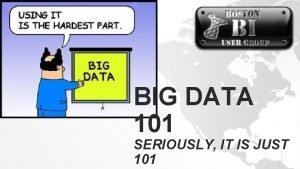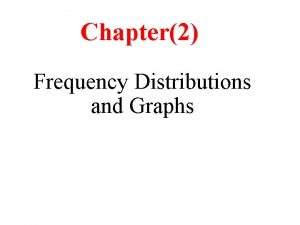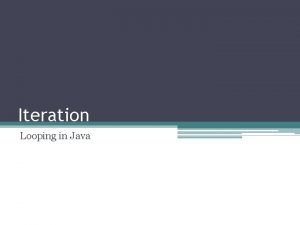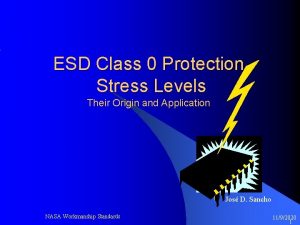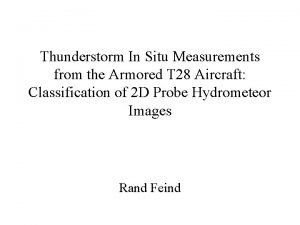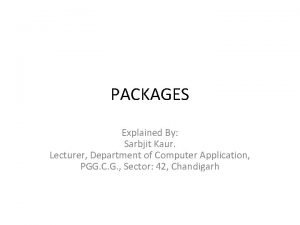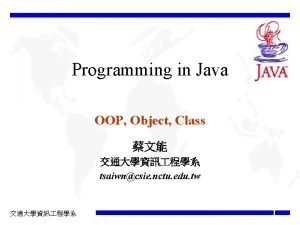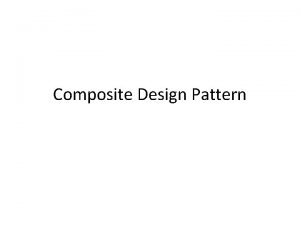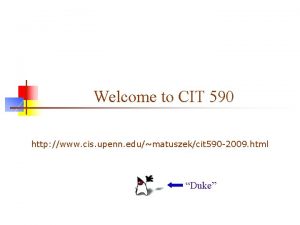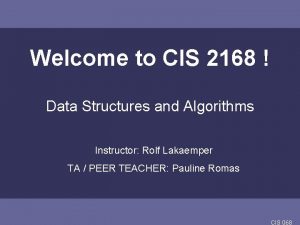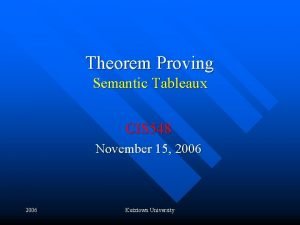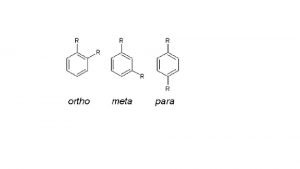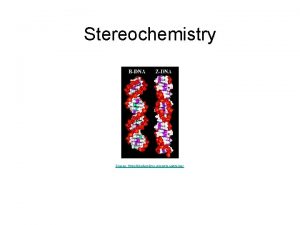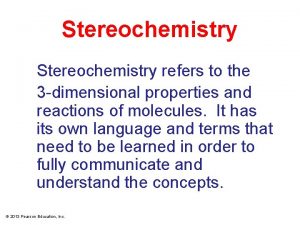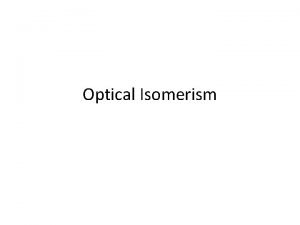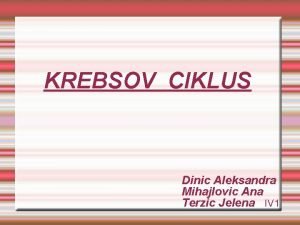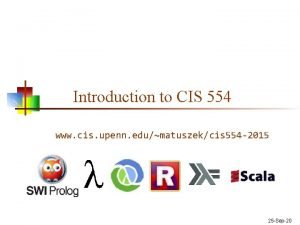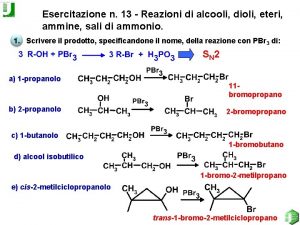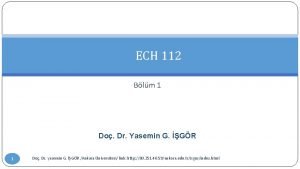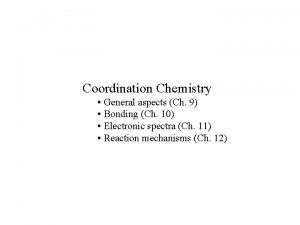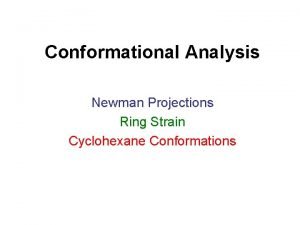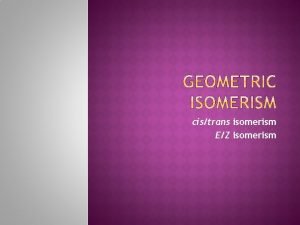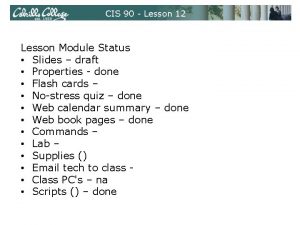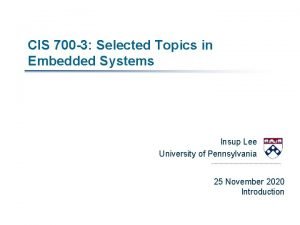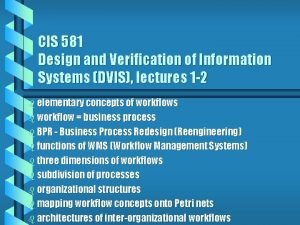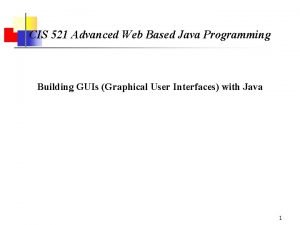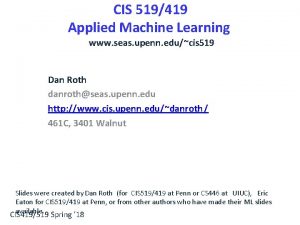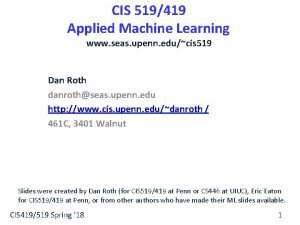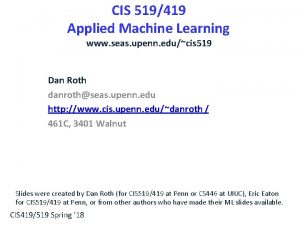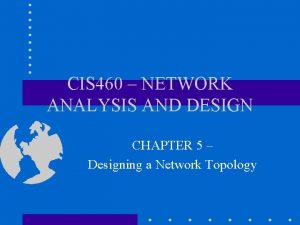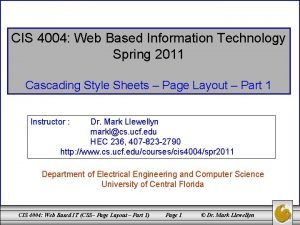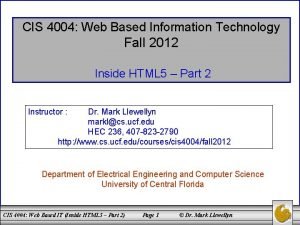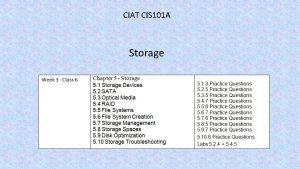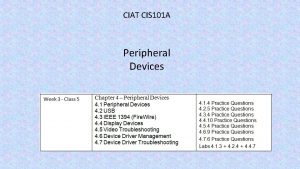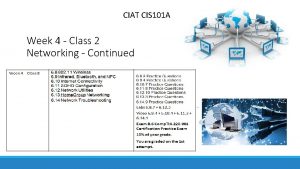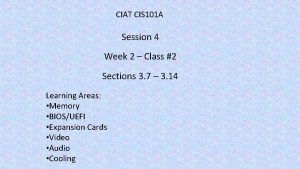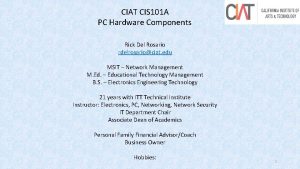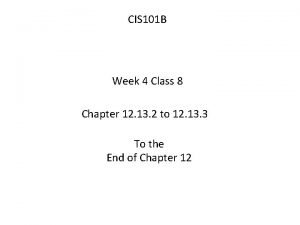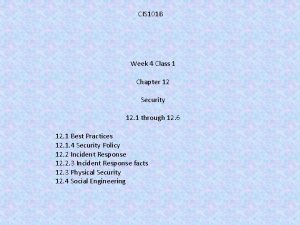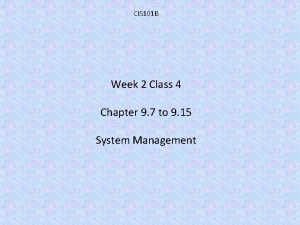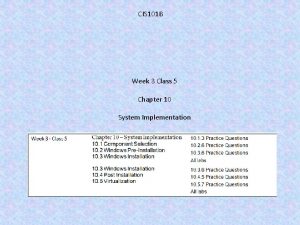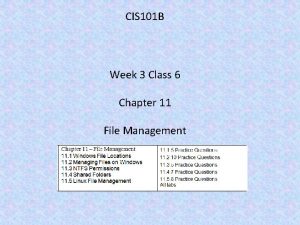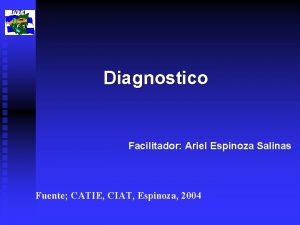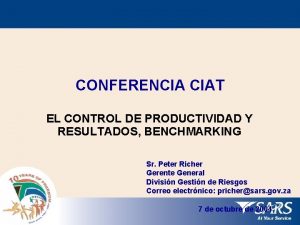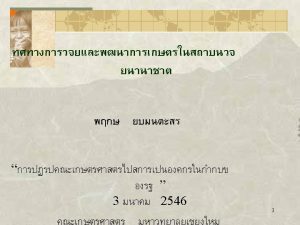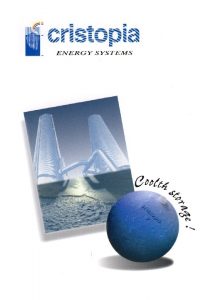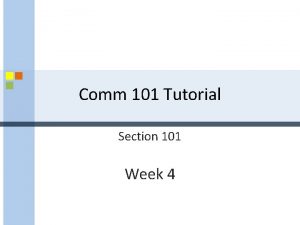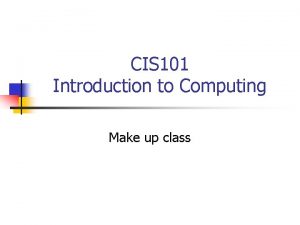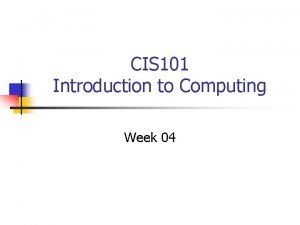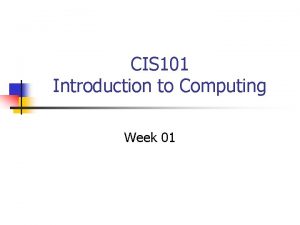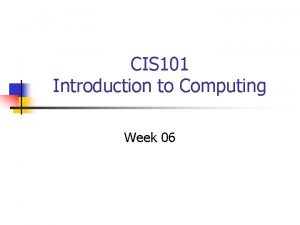CIAT CIS 101 A Week 2 Class 3






























































- Slides: 62

CIAT CIS 101 A Week 2 Class 3 Cases and Form Factors

CIAT CIS 101 A 3. 1 Cases and Form Factors: Motherboards adhere to design specifications called form factors. The form factor determines the physical characteristics of a motherboard, including its dimensions, number of expansion slots, and mounting hole locations, as well as the back panel dimensions, arrangement, and orientation. The following graphic and table describe the characteristics of the most common motherboard form factors:

CIAT CIS 101 A 3. 1 Motherboard Form Factors: The following table describes the characteristics of the most common motherboard form factors: Form Factor ATX Characteristics The ATX (advanced technology extended) form factor is the most commonly used form factor. Because of its popularity, several variants of the ATX form factor exist. Each variant has different specifications for dimensions and number of expansion slots. However, all ATX variants share the following characteristics: o Back plate measurements (6. 25" × 1. 75") o Power supply specifications: 1 - 24 -pin ATX power connector 2 - On/off switch runs from the case to the motherboard 3 - Soft-power control (OS can turn the computer off) o Expansion slot locations and spacing (0. 8" between slots) o Mounting hole locations o CPU location (top of board near power supply)

CIAT CIS 101 A Form Factor ATX Characteristics The ATX (advanced technology extended) form factor is the most commonly used form factor. Because of its popularity, several variants of the ATX form factor exist. Each variant has different specifications for dimensions and number of expansion slots. However, all ATX variants share the following characteristics: Back plate measurements (6. 25" × 1. 75") Power supply specifications: o 24 -pin ATX power connector o On/off switch runs from the case to the motherboard o Soft-power control (OS can turn the computer off) Expansion slot locations and spacing (0. 8" between slots) Mounting hole locations CPU location (top of board near power supply) Below are the most common ATX variants and their unique characteristics: Standard ATX The standard ATX form factor is the form factor that all other variants are modeled after. ATX motherboards: Measure 12" × 9. 6" Have up to seven expansion slots Have between six and nine mounting holes Extended ATX (EATX) The EATX form factor is the largest ATX variant. EATX: Measures 12" × 13" Typically uses extra space for additional memory slots micro. ATX The micro. ATX form factor is a smaller version of the ATX form factor. The micro. ATX form factor: Measures 9. 6" × 9. 6" Has four expansion slots

CIAT CIS 101 A Form Factor Characteristics ITX The ITX form factor was designed for low-power, small form factor (SFF) computers. The most common ITX form factor is the Mini-ITX form factor. The Mini-ITX form factor: Specifies a maximum motherboard size of 6. 7" × 6. 7" Has only one expansion slot Allows for small (100 watt) power supplies Is typically used with a home theater PC (HTPC) Other ITX form factors include the following: Nano-ITX (4. 7" × 4. 7") Pico-ITX (3. 9" × 2. 85") Mobile-ITX (2. 9" × 1. 7") The Mini-ITX form factor uses the same mounting locations and back panel specifications as the ATX form factor, allowing Mini-ITX motherboards to fit in ATX cases. NLX BTX NLX (new low profile extended) is an old form factor that was designed for use in slimline desktop computers. NLX: Uses a detachable riser card to provide expansion slots (the motherboard itself has no expansion slots). Allows the motherboard so it can slide in or out of the system case easily. Was replaced by micro. ATX and Mini-ITX. The BTX (balanced technology extended) form factor was designed as a replacement for the ATX form factor. However, it did not gain widespread adoption. With BTX: The CPU is positioned in such a way that air flow is increased. There is no heatsink fan. Instead, a thermal module or shroud fits over the CPU to move heat directly out of the system. The back panel orientation and mounting location is reversed. BTX was implemented mainly by computer manufacturers such as Dell.

CIAT CIS 101 A

3. 1 Computer Case Form Factors: Computer cases are designed to fit motherboard form factors. The following table describes the most common types of computer cases: Type Description ATX Full. Tower ATX full-tower cases are the largest computer cases. Full-tower cases have a lot of space for external and internal components. ATX full-tower cases are compatible with the following form factors: Standard ATX EATX micro. ATX Mid. Tower ATX mid-tower cases are slightly smaller than full-tower cases. Mid-tower cases have fewer external and internal bays. ATX mid-tower cases are compatible with the following form factors: Standard ATX micro. ATX Mini-ITX EATX (some) Micro. ATX Tower Micro-ATX towers are smaller cases designed to be placed on desktops. Micro-ATX towers typically only have one drive bay and are compatible with the following form factors: micro. ATX Mini-ITX Some Micro-ATX towers have a slim design. These cases are typically half the width of a Micro-ATX tower and are designed to lay flat or upright. Mini-ITX Tower HTPC Notebook Mini-ITX towers are designed to house Mini-ITX motherboards. They are typically smaller than Micro-ATX towers. Home theatre PC (HTPC) cases are designed to connect to TVs and be used as a home media computer. HTPC cases are compatible with micro. ATX and Mini-ITX form factors. Notebook cases are generally proprietary and often vary among models.

CIAT CIS 101 A 3. 1 Computer Case Form Factors: Computer cases are designed to fit motherboard form factors. The following table describes the most common types of computer cases: Type Description ATX Full. Tower o ATX full-tower cases are the largest computer cases. Full-tower cases have a lot of space or external and internal components. ATX full-tower cases are compatible with the following form factors: 1 - Standard ATX 2 – Extended ATX 3 - Micro ATX Mid. Tower o ATX mid-tower cases are slightly smaller than full-tower cases. Mid-tower cases have fewer external and internal bays. ATX mid-tower cases are compatible with the following form factors: ATX Micro. Tower o Micro-ATX towers are smaller cases designed to be placed on desktops. Micro-ATX towers typically only have one drive bay and are compatible with the following form factors: 1 – micro. ATX 2 – Mini-ATX Note: Some Micro-ATX towers have a slim design. These cases are typically half the width of a Micro-ATX tower and are designed to lay flat or upright.

CIAT CIS 101 A 3. 1 Computer Case Form Factors: Computer cases are designed to fit motherboard form factors. The following table describes the most common types of computer cases: Type Description Mini-ITX towers are designed to house Mini-ITX motherboards. They are typically smaller than Micro-ATX towers. HTPC Home theatre PC (HTPC) cases are designed to connect to TVs and be used as a home media computer. HTPC cases are compatible with micro. ATX and Mini-ITX form factors. Notebook cases are generally proprietary and often vary among models. Note: Some small form factor cases (e. g. , Micro-ATX and Mini-ITX towers) use riser cards for installing expansion boards. Riser cards are installed in an expansion slot and allow the expansion board to be installed parallel to the motherboard, instead of perpendicular.

CIAT CIS 101 A

CIAT CIS 101 A 3. 1 Computer Case Form Factors: When you purchase a computer case, it will usually come with the following components: o Computer Case o Power Supply (although the power supply might also be separate) o Case fans o Plastic or rubber feet that attach to the bottom of the case o Metal screws and standoffs for attaching the motherboard o Additional external connectors (such as audio, USB, and Fire. Wire) that connect to motherboard headers

3. 2 Power Supplies: CIAT CIS 101 A Power supplies are responsible for powering every component in a computer system. Power supplies perform the following functions: o Convert AC power to DC power 1 - AC (alternating current) is the type of current distributed through wall sockets. The voltage alternates between a negative and a positive charge, which is good for appliances requiring a high current. 2 - DC (direct current) is the type of current used inside a computer. Negative particles are drawn toward a positive charge, creating a unidirectional current flow. This type of predictable reliable current is ideal for an application where a lower current is required. o Provide components with the correct levels of DC voltage 1 - Standard ATX power supplies provide + 3. 3 volts, +/- 5 volts, and +/- 12 volts of DC power. Most modern components require +12 volt output. 2 - Each separate voltage output circuit is referred to as a rail and can power multiple devices. To avoid overloading one circuit, many newer power supplies have two or more +12 volt rails. These are known as dual rail power supplies. Separate rails balance the power load between multiple circuits, preventing any one circuit from becoming overloaded. o Aid in thermal management 1 - All ATX power supplies have a fan that cools the unit. 2 - The fan direction pulls cooler air from the front of the case and blows hot air out the back. Note: Older ATX units use a reverse air flow that blows air directly over the CPU. This method is not as efficient.

3. 2 Power Supplies: CIAT CIS 101 A You should be aware of the following facts about power supplies: o Power supplies should be matched to the motherboard and case form factor (i. e. , match an ATX power supply with an ATX motherboard or a Micro-ATX power supply with a micro. ATX motherboard). o Most power supplies have a voltage switch that toggles between 115 and 230 volt electricity. 1 - 115 volts is used in North America. 2 - 230 volts is used in Europe. Note: Some power supplies eliminate the voltage switch and instead automatically switch between voltages as necessary. These power supplies specify a voltage range they can function in. o Many power supplies have a switch on the back that turns the power on or off. o Power supplies are rated in watts. A power supply's watt rating determines its maximum power output. To determine a computer's power requirements, use the following method: 1 - Find the watt requirement for each component by multiplying volts by amps (W = V × A). 2 - Add each value together to find the total watt requirements. Note: Alternatively, there are several online tools you can use to estimate a computer's watt requirements. o ATX power supplies provide soft power—even when the computer is turned off, the motherboard has power. Soft power allows the computer to be turned on and off by the operating system or over the network.

CIAT CIS 101 A 3. 2 Power Supplies: When selecting a power supply, make sure it has all the necessary connectors for your components. The following table shows the common power supply connectors: Connector 24 -pin (20+4 pin) ATX connector Description The 24 -pin ATX power plug supplies power to the motherboard. 1 - Some 24 -pin connectors have one 20 -pin plug and a detachable 4 -pin plug. This allows for backwards compatibility with 20 -pin motherboards. 2 - You can plug a 24 -pin ATX power plug into a 20 -pin motherboard connector, leaving the four pins unconnected. Note: Older motherboards used 20 -pin power plugs. With a 24 -pin ATX power plug, the four extra pins supply an additional 3. 3, 5, and 12 volts of DC power.

CIAT CIS 101 A 3. 2 Power Supplies: When selecting a power supply, make sure it has all the necessary connectors for your components. The following table shows the common power supply connectors: Connector 4 -pin 12 v (P 4) power Description Starting with the Pentium 4 (P 4) processor, CPUs required more power than could be provided through the ATX power plug. The 4 -pin 12 V connector: 1 - Connects to the motherboard 2 - Provides two dedicated 12 V wires to the CPU (Older processors only used 5 V power) Note: The 4 -pin 12 V CPU connector is not the same as the 20+4 -pin ATX power connector.

CIAT CIS 101 A 3. 2 Power Supplies: When selecting a power supply, make sure it has all the necessary connectors for your components. The following table shows the common power supply connectors: Connector 8 -pin EPS 12 v CPU power Description Modern processors consume even more power. The 8 -pin EPS 12 V connector provides four lines of 12 V power. 1 - The 8 -pin EPS 12 V was originally used with some older dual processor systems. 2 - All modern multi-core processors use this connector. 3 - Some power supplies have two 4 -pin connectors (4+4) that are meant to be used side-by-side in the 8 -pin plug.

CIAT CIS 101 A 3. 2 Power Supplies: When selecting a power supply, make sure it has all the necessary connectors for your components. The following table shows the common power supply connectors: Connector 6+2 pin PCIe Description Newer video cards require more power than can be supplied through the PCI Express bus. The 6+2 -pin PCIe connector plugs directly into the video card to supply additional, dedicated power. The 6+2 -pin PCIe: 1 - Provides up to 150 watts 2 - Is also known as a PEG 6+2 (PCI Express Graphics 6+2 pin) 3 - Some motherboards only have a 6 -pin PCIe connector. These connectors provide up to 75 watts.

CIAT CIS 101 A 3. 2 Power Supplies: When selecting a power supply, make sure it has all the necessary connectors for your components. The following table shows the common power supply connectors: Connector 4 -pin peripheral power (Molex) Description The 4 -pin peripheral power connector (colloquially called a 4 -pin Molex connector) is used by legacy components (e. g. , IDE hard drives and PATA optical drives), case f ans, and other accessory devices. The connector provides both 5 V (red wire) and 12 V (yellow wire): 1 - Each power supply cable typically has multiple 4 -pin connectors on the same cable. 2 - When connecting devices, try to balance the devices connected to each cable.

CIAT CIS 101 A 3. 2 Power Supplies: When selecting a power supply, make sure it has all the necessary connectors for your components. The following table shows the common power supply connectors: Connector SATA power Description The SATA power connector has 15 pins and provides 3. 3, 5, and 12 volts. As its name implies, it powers SATA device: 1 - You can use a special adapter to convert a 4 -pin peripheral power connector to a SATA connector. 2 - When using an adapter, or on some power supplies, the connector only supplies 5 and 12 volts. Note: The SATA data cable is a smaller cable that plugs in along side the power cable on the SATA drive.

CIAT CIS 101 A 3. 2 Power Supplies: When selecting a power supply, make sure it has all the necessary connectors for your components. The following table shows the common power supply connectors: Connector 4 -pin mini-Molex Description The 4 -pin mini-Molex connector provides both 5 and 12 volts and is used by floppy drives. 1 - You can use a special adapter to convert a 4 -pin peripheral power connector to a SATA connector. 2 - Most modern power supplies do not have a 4 -pin mini-Molex connector. Note: If your power supply does not have some of the required connectors (such as for the CPU, video card, or SATA device), you can purchase adapters to convert from one connector to another.

3. 2 Power Supplies: CIAT CIS 101 A When troubleshooting a power supply, keep the following in mind: o Symptoms of bad power supply include: 1 - The computer does not turn on 2 - The computer sporadically shuts off or reboots 3 - A broken or noisy fan o Before opening up the computer, rule out the obvious. Make sure: 1 - The power cord is plugged into the wall. 2 - The power switch is in the on position. 3 - The voltage switch is set to the correct voltage. (110 or 220 volts) o Test the power supply using a multimeter or power supply tester. Voltage levels should be within +/- 5% of normal. If they aren't, the power supply is bad or failing and should be replaced. Note: When using a multimeter, the power supply can be turned on by bridging (shunting) pin 16 and a ground pin (i. e. , pin 15 or 17) with a bent paperclip. o Because power supplies carry dangerous levels of electrical current, always take proper safety precautions. 1 - Never ground yourself when working on a power supply. 2 - Never open or disassemble a power supply. Always replace the entire unit. Note: Some computer manufacturers, such as Dell or HP, produce proprietary power supplies. These power supplies might have a unique shape or use different wiring schematics on connectors. When replacing a power supply, identify whether a standard ATX or a proprietary power supply is required.

CIAT CIS 101 A 3. 3 Motherboards and Buses: A motherboard (also called system board, logic board, or mainboard) is a circuit board that either houses or is connected to all of the components operating in the computer. When selecting a motherboard, consider the following motherboard specifications: o CPU Socket Type o Memory module compatibility o Number of memory slots o Maximum supported memory o Expansion slots and types o Onboard devices (video, audio, or network)

CIAT CIS 101 A 3. 3 Motherboards and Buses: A typical motherboard includes the following components: Component CPU Socket Function / Characteristic The CPU socket houses the CPU. There a variety of CPU socket types, each of which have unique shapes, pin arrangements, or mounting configurations. Because of this, it's important to match the motherboard socket type with the processor socket type. Some motherboards support multiple processors and have a socket for each CPU Memory Slots Most motherboards have multiple memory slots. Memory slots are designed to be compatible with a specific type of memory module Expansion slots (also called expansion buses) allow you to expand the capabilities of your computer by installing expansion cards. There a number of different expansion slot types: 1 - PCI (Peripheral Component Interconnect) 2 - PCI-X (Peripheral Component Interconnect Extended) 3 - PCIe (Peripheral Component Interconnect Express) 4 - Accelerated Graphics Port (AGP) [Legacy Now]

CIAT CIS 101 A 3. 3 Motherboards and Buses: (continued) A typical motherboard includes the following components: Component Onboard Components of I/O Connectors Function / Characteristic Many motherboards include onboard components (such as network cards, audio cards, video cards, or USB and Fire. Wire connections). Selecting a motherboard with onboard devices is typically cheaper than buying separate expansion cards for each feature. However, the quality these onboard devices might not be as high as dedicated expansion cards. I/O connectors for onboard components are located on the back of the motherboard. These connectors typically include the following: o PS/2 mouse and keyboard ports (legacy) o USB ports o Serial ports (COM 1, 2, 3, and 4) (legacy) o Parallel ports (legacy) o Audio Jacks o Ethernet port

CIAT CIS 101 A 3. 3 Motherboards and Buses: (continued) A typical motherboard includes the following components: Component Internal connectors Function / Characteristic There a number of connectors on motherboards for components such as power supplies, fans, and LED lights. Computer cases often have front panel ports (e. g. , USB, Fire. Wire, or audio ports) that need to be connected to the motherboard. These ports are connected to the motherboard's front panel connectors, which are also called headers. Note: Expansion ports that are not available on the motherboard are often added using expansion cards Firmware The firmware on a motherboard is stored on integrated flash memory. Motherboards use one of two firmware implementations: 1 - BIOS (Basic Input/Output System) 2 - UEFI (Unified Extensible Firmware Interface) Note: Older motherboards stored the BIOS on removable, read-only memory (ROM) chips.

CIAT CIS 101 A 3. 3 Motherboards and Buses: (continued) A typical motherboard includes the following components: Component CMOS Battery Function / Characteristic The CMOS battery is used to keep an accurate date and time, even when the motherboard has no power. In older motherboards, the CMOS battery was also used to retain BIOS configuration settings, which were stored in volatile memory called the CMOS chip. Chipset The chipset is a group of chips that facilitates communication between the processor, memory, and peripheral devices. Older chipsets consist of two integrated circuits: o The northbridge chip sits near the CPU and handles the flow of all data to and from the processor via the front-side bus (FSB). The northbridge also provides control for the following components: 1 – Memory bus 2 – High speed graphics bus (PCIe) 3 – Southbridge communications o The southbridge chip sits "south" of the northbridge. The southbridge includes the following systems: Note: The southbridge also communicates with the 1 – Real-time clock Super I/O controller, which contains multiple embedded 2 – Power Management Controls 3 – PCI bus and USB device controllers including the keyboard controller.

CIAT CIS 101 A 3. 3 Motherboards and Buses: (continued) A typical motherboard includes the following components: Component Function / Characteristic Chipset to Most modern motherboards have moved away from a northbridge/southbridge chipset model a more efficient one. With modern chipsets: o The memory controller and graphics controller are on the CPU, instead of the northbridge. o The remaining northbridge functionality and all of the southbridge functionality are combined into a single controller chip. 1 - Intel processors use the Platform Controller Hub (PCH). 2 - AMD processors use the Fusion Controller Hub (FHC). o The front-side bus is replaced by the Direct Media Interface (DMI). Support Manual A motherboard's support manual is an excellent source of information. Support manuals contain technical specifications as well as diagrams that identify the motherboard's components. If you are missing a motherboard's support manual, check the manufacturer's website. Note: Selecting a motherboard with the same form factor as the case and power supply is an easy way to assure compatibility.

CIAT CIS 101 A 3. 3 Motherboards and Buses: (continued) A typical motherboard includes the common connectors shown in the following diagram:

CIAT CIS 101 A 3. 3 Motherboards and Buses: (continued) Motherboard Installation Repairing a motherboard is beyond the skill of most technicians and it is almost always cheaper and faster to purchase a new one. You might also need to replace your motherboard to add new features or to upgrade the processor. Use the following process when installing or replacing a motherboard: 1 - If you are replacing an existing motherboard, document the current CMOS settings. You might need these settings to configure the new motherboard. 2 - Install the CPU, heatsink, and memory before installing the motherboard in the case. 3 - Insert the I/O shield into the case. 4 - Fasten standoffs to the case, being sure to match the hole pattern on the motherboard. The standoffs prevent the motherboard circuits from touching the system case. 5 - Install the motherboard, securing it to the standoffs with insulated washers and screws. 6 - Connect the power and accessory cables: A. Connect the ATX power cable and the CPU power cable. B. Connect the CPU fan power cable. C. Connect case wires (e. g. , power switch, reset switch, and drive activity and power lights). D. Connect any case fan cables. 7. Connect drives to SATA connectors. Consult the motherboard's documentation to 8. Install additional devices in expansion slots. identify the location and configuration of 9. Connect wires for front/top panel ports (e. g. , USB, audio, or e. SATA). front/top panel ports and case wires. 10. Document the settings of the new motherboard.

CIAT CIS 101 A 3. 4 Motherboard Troubleshooting: Common motherboard issues include those discussed in the following table: Issue Power Issue Description Power supplies wear out over time, especially if they're overheated or overstressed. If the power supply can't provide adequate amounts of electricity to the system, the computer may exhibit one of several behaviors: 1 - It may unexpectedly shut down. 2 - It may continuously reboot itself. 3 - It may not power on at all. Pin 8 on the power supply connector connects to the power good wire on the motherboard. If power disappears off that wire, the motherboard shuts down. If power quickly reappears on that wire, the system may attempt to come back on by itself, resulting in continual reboots. If power does not reappear on this wire, then the system will shut off. For example, a failing power supply may not provide enough voltage on this wire for the system to initially boot up. If these symptoms are observed, test the power supply to determine if it's the source of the problem. Turn the power supply on and then test the voltage supplied on either a motherboard connector or on a hard disk connector.

CIAT CIS 101 A 3. 4 Motherboard Troubleshooting: (continued) Common motherboard issues include those discussed in the following table: Issue Power Issue Description Boot Errors A malfunctioning motherboard may generate error codes when the system is powered on. Every time the PC boots, it runs a Power On Self-Test (POST) to make sure all of the basic hardware in the system is present and functioning correctly. If a problem is identified during POST, an error is generated. How the error message is reported to the end user depends upon the motherboard manufacturer. If the voltage is less than expected, then the power supply may be at fault. For example, if a 12 volt wire is carrying less than 11 volts, the power supply is probably failing. If this is the case, do the following to rectify the issue: 1 - Purchase a new power supply. 2 - Remove the old power supply from the system 3 - Mount the new power supply. 4 - Connect the new power supply to the motherboard and to all other internal devices. 5 - Power the system on and verify that the symptoms have been eliminated.

CIAT CIS 101 A 3. 4 Motherboard Troubleshooting: (continued) Common motherboard issues include those discussed in the following table: Issue Boot Errors Description The following may be used for POST indicators: 1 - Audible beeps 2 - Numeric codes 3 - Error messages The actual codes and messages will vary by manufacturer. Check the motherboard documentation for specific details. For example, a numeric 201 error code may indicate a memory problem on some systems, while a 301 error indicates the keyboard did not respond correctly during POST.

CIAT CIS 101 A 3. 4 Motherboard Troubleshooting: (continued) Common motherboard issues include those discussed in the following table: Issue Boot Errors Description Sometimes, a computer system may experience problems (such as a malfunctioning video adapter) that can prevent error messages from being displayed during POST. If this is the case, use a POST card to access POST error codes. Most models use an LED display to report any error codes generated during POST. A POST card is commonly implemented as an expansion board that is inserted into an expansion s lot in the motherboard. However, some POST cards also include a USB interface that allows them to be connected to computers that don’t have expansion slots, such as a notebook system.

CIAT CIS 101 A 3. 4 Motherboard Troubleshooting: (continued) Common motherboard issues include those discussed in the following table: Issue Distended Description Over time, the capacitors on the motherboard may become overstressed or overheated. When Capacitors this happens, they may bulge or even begin to leak fluid. Distended capacitors usually fail at some point, causing the motherboard to fail. For example, if the fans in the power supply spin up when you power on a system, but the motherboard itself doesn't start, it is possible that capacitors on the motherboard have become distended. If this happens, inspect the motherboard and look for capacitors that are swollen on top or leaking brown liquid. While it is possible to carefully replace a failed capacitor on the motherboard, it is usually faster and more cost effective to replace the entire motherboard.

CIAT CIS 101 A 3. 4 Motherboard Troubleshooting: (continued) Common motherboard issues include those discussed in the following table: Issue Missing BIOS/UEFI Settings Description A constant source of power is required to store the settings configured in the motherboard BIOS/UEFI chipset. The motherboard also needs constant power to keep the system clock running while the system is powered off. Most motherboards implement a small battery that provides this power. If this battery starts to fail, then the following may occur when the system is powered on: 1 - The system clock loses time. 2 - Settings configured in BIOS/UEFI are lost. Note: If this happens, it's likely that the motherboard battery has failed and needs to be replaced.

CIAT CIS 101 A 3. 4 Motherboard Troubleshooting: (continued) Common motherboard issues include those discussed in the following table: Issue Overheating Description Internal system components within a computer generate a great deal of heat that must be dissipated. Overheating causes premature component failure. Overheating could be caused by several conditions: 1 - Inadequate air flow. This may be the result of an inadequate number of fans in the system or fans that are too small. In this situation, additional fans can be added to the system to increase air flow. 2 - Improperly installed fans. Fans must be oriented to force air through the system in the same direction, otherwise they may fight against each other and prevent air from flowing properly. 3 - Failing fans. A failing fan moves less air than a properly functioning fan. It's not uncommon for a failing fan to generate a screeching noise that is caused by worn parts within the fan assembly. This condition can be fixed by replacing the failing fan. 4 - Dust buildup. Excessive dust within the system can block air flow and cause overheating. Use compressed air or an anti-static vacuum to remove dust buildup. 5 - Environmental heat. If the air temperature outside the computer is already overly-warm, then the temperature inside will be overly-warm as well. A properly balanced HVAC system must be implemented in the work area to remove excess heat from the environment.

CIAT CIS 101 A 3. 4 Motherboard Troubleshooting: (continued) Common motherboard issues include those discussed in the following table: Issue Overheating Description The internal temperature of computer systems should be monitored. Most motherboards include several sensors that can be used to monitor the system temperature. Usually, the current temperature can be viewed within the BIOS/UEFI setup. There also software applications available that can read the current temperature values from the sensors and display them on screen. Unlike using a BIOS/UEFI monitoring utility, these tools allow the temperature to be monitored dynamically while the system is in use. Most motherboards include a thermal shutdown feature. If the system temperature rises too high, thermal shutdown feature immediately shuts the computer down to prevent component damage. However, it typically does not shut the system down cleanly, so there is a risk of data corruption if this happens.

CIAT CIS 101 A 3. 4 Motherboard Troubleshooting: (continued) Common motherboard issues include those discussed in the following table: Issue Intermittent Device Failure Description Intermittent device failure occurs when a component occasionally stops working. This usually indicates that the device itself is failing. The best remedy is to replace the failing device because it will fail completely at some point. Immediate replacement prevents this from happening. Intermittent device failures may also be caused by device drivers that aren't functioning properly. Device drivers are software and may contain coding errors. Before replacing a device experiencing intermittent failures, first verify that the latest drivers for that device have been loaded. Sometimes downloading the latest driver and installing it will solve the problem. If it doesn’t, then the device itself may need to be replaced.

CIAT CIS 101 A 3. 4 Motherboard Troubleshooting: (continued) Common motherboard issues include those discussed in the following table: Issue Smoke or Burning Smell Description If smoke or a burning smell is observed coming from a computer, it indicates that electricity is not flowing in the correct manner within the system. If smoke is observed, shut the system off immediately. This issue could be caused by: 1 - A connector that isn't seated properly and electricity is arcing between leads. 2 - A short circuit in the printed circuit board of the motherboard itself or on an expansion board. 3 - An improperly installed component. Unfortunately, a component that is smoking has probably already been damaged to some degree. It's unlikely that it will ever function properly again. Replacement components are usually required.

CIAT CIS 101 A 3. 5 Processors: When selecting a Central Processing Unit (CPU), you will need to match the motherboard and the CPU. Either select a CPU supported by the motherboard, or select a motherboard that will support the processor you have chosen. The following table lists several considerations for choosing a processor: Feature Description CPU Intel and AMD are the two major producers of processors used in modern PCs Manufacturer 1 - Both Intel and AMD processors work in PC systems and support Windows software. 2 - Intel has a larger market share, while AMD processors generally cost less. 3 - Processor performance and special features vary between models and manufacturers. Note: Intel tends to use pin-less processor chips, and usually have graphics logic built into the processor chips. AMD on the other hand still use pins on their processor chips, and have no graphics built into their processors. Note: Most technicians would use Intel for general purpose computer work, because graphics is built into the chip. Gamers might prefer AMD with are cheaper and they can add their own high performance graphics cards.

CIAT CIS 101 A 3. 5 Processors: (continued) When selecting a Central Processing Unit (CPU), you will need to match the motherboard and the CPU. Either select a CPU supported by the motherboard, or select a motherboard that will support the processor you have chosen. The following table lists several considerations for choosing a processor: Feature Description 32 -bit or 64 -bit A 32 -bit processor can process 32 -bits of information at a time; a 64 -bit processor can process 64 bits of information. 1 - The biggest advantage of 64 -bit processors over 32 -bit processors is in the amount of memory they can use. 32 -bit processors have a limit of 4 GB. 64 -bit processors have a theoretical limit of 16 EB, although operating system and current hardware limitations impose a much lower practical limit. 2 - The operating system and applications must be written for 64 -bits to take full advantage of 64 bit processing. 3 - The processor instruction set identifies all instructions (operations) that a processor can perform A. 32 -bit processors use the IA-32 instruction set (also referred to as x 86). B. Itanium processors from Intel use the IA-64 instruction set. C. AMD 64 and Intel 64 processors use the x 86 -64 instruction set (also referred to as x 64).

CIAT CIS 101 A 3. 5 Processors: (continued) When selecting a Central Processing Unit (CPU), you will need to match the motherboard and the CPU. Either select a CPU supported by the motherboard, or select a motherboard that will support the processor you have chosen. The following table lists several considerations for choosing a processor: Feature Description 32 -bit or 64 -bit 32 -bit applications can run on 64 -bit processors using the following methods: 1 - Itanium processors use a software layer to translate between IA-32 and IA-64. 2 - x 64 processors execute both 32 -bit and 64 -bit instructions in the hardware. 3 - You can run a 32 -bit operating system on a computer with a 64 -bit processor. Applications typically perform better on 64 -bit systems. 1 - 64 -bit applications typically perform better than 32 -bit applications. 2 - In some cases, 32 -bit applications might perform better on 64 -bit systems.

CIAT CIS 101 A 3. 5 Processors: (continued) When selecting a Central Processing Unit (CPU), you will need to match the motherboard and the CPU. Either select a CPU supported by the motherboard, or select a motherboard that will support the processor you have chosen. The following table lists several considerations for choosing a processor: Feature Description Multi-core A multiple core processor has multiple processors within a single processor package. 1 - Dual-core, triple-core, and quad-core processors are typical in desktop systems. 2 - Multi-core systems enable the operating system to run multiple applications simultaneously. Without multiple processors, applications appear to run at the same time, but must wait their turn for processing time from the single processor. 3 - Some applications can be written to execute on multiple processors at the same time. 4 - Some motherboards use two (or more) processor sockets to provide a multiple processor solution. Multi-core processors use a single motherboard socket to support multiple processors.

CIAT CIS 101 A 3. 5 Processors: (continued) When selecting a Central Processing Unit (CPU), you will need to match the motherboard and the CPU. Either select a CPU supported by the motherboard, or select a motherboard that will support the processor you have chosen. The following table lists several considerations for choosing a processor: Feature Description Speed Processors operate using an internal clock that is the same as, or is a multiple of, the motherboard bus speed. The speed is represented in megahertz (MHz) and is also referred to as the frequency. 1 - You can purchase processors of the same type but with different speed ratings. 2 - When selecting a processor, make sure the motherboard supports the processor speed by reading the motherboard documentation first. 3 - Most motherboards automatically detect the processor speed. If not, you might need to use jumpers or edit the CMOS to configure the processor speed.

CIAT CIS 101 A 3. 5 Processors: (continued) When selecting a Central Processing Unit (CPU), you will need to match the motherboard and the CPU. Either select a CPU supported by the motherboard, or select a motherboard that will support the processor you have chosen. The following table lists several considerations for choosing a processor: Feature Description Cache is memory that the processor can access directly without using the system RAM. There are four types of processor cache: 1 - Level 1 (L 1) cache is integrated on the processor die itself and stores instructions for the processor. On multi-core systems, each processor typically has its own L 1 cache. Some processors might have two L 1 caches, one for instructions and one for data. 2 - Level 2 (L 2) cache is additional cache used for both instructions and data. Depending on the processor, L 2 cache might be shared between two or more cores, or exclusive to a single core. 3 - Level 3 (L 3) cache is additional cache beyond the level 2 cache. For multi-core systems, L 3 cache is shared between all cores. 4 - Level 4 (L 4) cache is shared dynamically between the on-die graphics processor unit (GPU) and CPU.

CIAT CIS 101 A 3. 5 Processors: (continued) When selecting a Central Processing Unit (CPU), you will need to match the motherboard and the CPU. Either select a CPU supported by the motherboard, or select a motherboard that will support the processor you have chosen. The following table lists several considerations for choosing a processor: Feature Description Cache Be aware of the following regarding processor cache: 1 - The size of the cache increases as you move from L 1 to L 4, with L 1 cache being the smallest. 2 - As a general rule, a processor with more cache performs better than a processor with less cache (all other things being equal). 3 - Originally, only L 1 cache was on the processor die, with L 2 cache being on the motherboard between the CPU and the RAM. As processor technology has advanced, L 2 cache moved to the processor die, with L 3 cache being on the motherboard. Today, all three cache levels are located on the processor. 4 - The L 4 cache acts an overflow cache for the L 3. Information evicted from L 3 is dumped into L 4.

CIAT CIS 101 A 3. 5 Processors: (continued) When selecting a Central Processing Unit (CPU), you will need to match the motherboard and the CPU. Either select a CPU supported by the motherboard, or select a motherboard that will support the processor you have chosen. The following table lists several considerations for choosing a processor: Feature Description Process size The process size refers to the manufacturing process used to etch transistors onto the silicon wafer that will become the CPU. A smaller process size means smaller transistors, which translates into a smaller CPU die with more transistors and less power consumption. Process size is expressed in microns (such as. 25 microns) or nanometers (90 nm which equals. 09 microns). Hyper-Threading Hyper-threading is a feature of some Intel processors that allows a single processor to run threads (instructions) in parallel, as opposed to processing threads linearly. Hyper-threading enables a processor to execute two threads at the same time. For example, on a quad-core Intel system that supports hyper-threading, the processor can execute 8 threads at a time (2 on each core). Hyper-threading is not the same as multithreading. Multithreading is a feature of an application that allows it to send multiple threads at the same time. Applications are typically written to support multithreading to take advantage of multiple cores (executing threads on two or more processors at the same time) or hyper-threading features.

CIAT CIS 101 A 3. 5 Processors: (continued) When selecting a Central Processing Unit (CPU), you will need to match the motherboard and the CPU. Either select a CPU supported by the motherboard, or select a motherboard that will support the processor you have chosen. The following table lists several considerations for choosing a processor: Feature Description Throttling is the process of modifying the operating characteristics of a processor based on current conditions. 1 - Throttling is often used in mobile processors to change the operating frequency to minimize power consumption and heat output. 2 - Throttling can also be used in low memory conditions to slow down the processing of I/O memory requests, processing one sequence at a time in the order the request was received. 3 - Related to throttling, processors or the operating system can shut down unused cores in multicore systems to conserve energy.

CIAT CIS 101 A 3. 5 Processors: (continued) When selecting a Central Processing Unit (CPU), you will need to match the motherboard and the CPU. Either select a CPU supported by the motherboard, or select a motherboard that will support the processor you have chosen. The following table lists several considerations for choosing a processor: Feature Description Overclocking is pushing a CPU beyond its designed specifications. Overclocking can give you a marginal increase in performance, but will decrease your CPU's life. Some Intel processors include a Turbo Boost feature. Turbo Boost, the opposite of throttling, allows the processor to dynamically run above its rated speed to improve performance. Unlocked processors are processors whose speed can be changed above their rated speed through overclocking. 1 - With overclocking, you increase the speed and often the voltage to increase the performance of the processor. 2 - Overclocking typically voids the CPU warranty and could lead to shorter component lifetimes. 3 - Some multi-core processors (such as a triple core CPU) have additional cores that have been disabled. With the appropriate motherboard support, you might be able to unlock and use the additional core(s). However, stability of the extra cores is not guaranteed.

CIAT CIS 101 A 3. 5 Processors: (continued) When selecting a Central Processing Unit (CPU), you will need to match the motherboard and the CPU. Either select a CPU supported by the motherboard, or select a motherboard that will support the processor you have chosen. The following table lists several considerations for choosing a processor: Feature Description Mobile CPUs are used in mobile computers and cell phones where portability and mobility are a processors concern. Special versions of processors are built to minimize power consumption and the amount of heat generated. Virtualization is the ability to install and run multiple operating systems simultaneously on a single physical machine. Virtualization typically includes the following components: a physical machine, hypervisor, virtual machine, and virtual hard disk (VHD). The virtual machines appear as self-contained and separate physical systems. 1 - Virtualization is performed by adding a thin layer of software, called a hypervisor, between the physical system and the operating system. A hypervisor allows virtual machines to interact with the hardware without going through the host operating system. 2 - Early virtualization was performed using software only. Newer virtualization uses special instructions supported by the processor to improve performance.

CIAT CIS 101 A 3. 5 Processors: (continued) When selecting a Central Processing Unit (CPU), you will need to match the motherboard and the CPU. Either select a CPU supported by the motherboard, or select a motherboard that will support the processor you have chosen. The following table lists several considerations for choosing a processor: Feature Description Virtualization 3 - There are several different types of hypervisor software. (continued) A. VMware Workstation and ESX (made by VMware) B. Hyper-V (made by Microsoft) C. XEN (open source) 4 - If you are planning on implementing a virtual solution, check to see whether hardware support in the CPU is required. Hardware support is provided by processors with the following features: A. Intel's Virtualization Technology (VT) B. AMD's AMD Virtualization (AMD-V)

CIAT CIS 101 A 3. 5 Processors: (continued) When selecting a Central Processing Unit (CPU), you will need to match the motherboard and the CPU. Either select a CPU supported by the motherboard, or select a motherboard that will support the processor you have chosen. The following table lists several considerations for choosing a processor: Feature Description Integrated In a traditional processor design, the processor is connected to the front side bus and the memory Northbridge chip. The processor communicates with other system components through the front controller side bus. Smaller manufacturing size has reduced the overall size of a processor, leaving more room on the processor die for additional cores or cache. To improve performance, some processors include the memory controller with an integrated graphics processing unit (GPU) on the processor die rather than in the Northbridge chip, resulting in faster memory access by the processor. Cooling Processors require some form of heat dissipation system to function properly. Without a heat dissipation system, a processor will overheat and burn out in less than a minute. CPUs use a heat sink, fan, thermal paste, liquid, or fanless cooling system to transfer heat from the CPU to the cooling unit.

CIAT CIS 101 A

CIAT CIS 101 A 3. 5. 3 CPU Performance: For a long time, processor clock speed was used as a measure of processor performance. This is not necessarily true for newer processors for the following reasons: o If two processors are of the same type, higher speed typically means higher performance. With processors of different types, speeds might not be comparable. o It is important to make sure your motherboard can support the speed of your processor. o Many processors use a performance rating instead of speed with a higher number indicating a better-performing processor. However, performance ratings are typically only applicable between models of the same manufacturer. o In some cases, buying a processor with double the cache can nearly double the performance. o Dual core processors offer better performance, but typically not double. Software must be specially written to take best advantage of the dual core processors. o Special instruction sets supported by a processor can increase performance. For example, hyper-threading support on Intel processors can boost performance for specific types of operations. o Performance can also be increased by modifying other system components such as adding more RAM, using a faster disk, or improving cooling and ventilation.

CIAT CIS 101 A 3. 5. 3 CPU Performance: (continued) For a long time, processor clock speed was used as a measure of processor performance. This is not necessarily true for newer processors for the following reasons: o Overclocking is a feature that causes the processor to operate at a higher speed. Overclocking is typically performed by those who want to get the maximum performance from their systems. Some important things to know about overclocking are: 1 - Overclocking can cause system instability, component damage, and can void your warranty. 2 - Motherboard bus, processor, and memory settings should be adjusted to match the overclock speed. 3 - Overclocking may require more voltage. 4 - Overclocking often increases heat output. For this reason, it may be necessary to upgrade your cooling devices.

CIAT CIS 101 A 3. 5. 6 CPU Installation: Remember the following when installing a CPU: Installation Step Prepare for Installation Description Preparing for a CPU installation will help to ensure that your new components are not damaged before installation. 1 - Use anti-static protection when installing a CPU. 2 - The CPU and motherboard socket type must match. The socket identifies the number and layout of pins. 3 - In addition to the socket type, the motherboard must support the processor speed. 4 - Verify how heat connectivity will be established between the CPU and heatsink.

CIAT CIS 101 A 3. 5. 6 CPU Installation: (continued) Remember the following when installing a CPU: Installation Step Insert CPU Chip Description Inserting the CPU is simple. (but you must be very careful at the same time) 1 - Handle the CPU by the edges without touching the underneath connectors. 2 - A Zero Insertion Force (ZIF) socket uses a lever to allow installation of the processor. Drop the processor into place, then push down on the lever to lock the processor into place. 3 - When installing a CPU, be sure to orient the CPU appropriately with the socket. A. In most cases, the pin array is keyed so that the CPU can be inserted in only one way. B. For processors that can be inserted multiple ways, be sure to line up pin 1 on the processor with pin 1 in the processor slot. Pin 1 is typically identified with a dot or a triangle. 4 - When installing a processor in a multi-processor system, unused processor slots must be filled with a special terminating resistor. 5 - When adding multiple processors in a multi-processor system, be sure that the speed of the processors are the same.

CIAT CIS 101 A 3. 5. 6 CPU Installation: (continued) Remember the following when installing a CPU: Installation Step Install Heatsink and Fan Description Connect Fan Power When the CPU includes a fan, be sure to connect the fan power to the motherboard. Configure CMOS Settings Most motherboards automatically detect the processor speed. If not, you might need to use jumpers or edit the CMOS to configure the processor speed. For newer processors released after the motherboard, you might be able to add support for the processor by updating the BIOS. 1 - Typically, the processor will run at a speed lower than its rating if the motherboard does not support the higher speed. 2 - As a best practice, you should update the BIOS shortly after installing the processor (you must have a processor and memory installed to update the BIOS). The heatsink and fan are installed on top of the CPU. 1 - CPUs require a heatsink, and most desktop systems also use a fan for cooling. 2 - When installing a heat sink, use thermal grease or a thermal pad between the processor die and the heat sink. This maximizes heat transfer between the processor and the CPU.

CIAT CIS 101 A 3. 5. 6 CPU Installation: (continued) Remember the following when installing a CPU: Installation Step Troubleshoot as to not enter the loaded Description If you are having problems, do the following to troubleshoot your installation: 1 - Spontaneous reboot or intermittent system crashes: An overheated CPU will cause a spontaneous reboot or intermittent system crashes. A spontaneous reboot can also be caused by a bad power supply or device driver. A clicking noise when reading or writing data from the hard disk is an early sign of a failing drive. 2 - System lockups and restarts: Because you have just replaced the processor, the most likely cause of the problem is related to the CPU. System lockups and restarts can be caused by an overheated processor. Make sure the CPU fan is running, and that you have used thermal paste between the CPU and the heat sink. 3 - System beeps regularly, nothing is shown on the screen and it doesn't start: Flashing the BIOS is often required to upgrade system components that are part of the motherboard, such upgrade to a faster processor. If the motherboard lists the processor as supported but it is correctly recognized, update the BIOS to the latest version. Press F 8 while booting to advanced boot menu when Windows loads. However, this option assumes the BIOS has correctly and the computer passed the POST tests. Replacing the motherboard is likely not required as the motherboard was working correctly and the documentation states the CPU is compatible with the motherboard. Only replace the CPU after you have determined that it is faulty.

CIAT CIS 101 A 3. 6 Processor Troubleshooting: Symptoms of a failed or failing CPU include: o System will not boot. o System boots, but the operating system fails to load. o System has POST parity problems with a number of devices. o System locks up shortly after startup: A. This symptom is possibly thermal issue. Check for this problem by shutting down, letting the system cool off, and restarting the computer to verify whether the problem repeats itself. Check the following if overheating seems to be the problem: 1. Check the heatsink and fan for placement and condition. 2. Verify that thermal paste or a thermal pad has been used between the processor and the heat sink. 3. Ensure the heatsink is firmly attached to the CPU. 4. Verify that the CPU is properly seated in its socket. 5. Make sure system case fans are working and that the case and expansion slots are in place. B. If the computer is not overheating but has this symptom, the problem could be the clock or system timers in the BIOS/UEFI are set incorrectly.

CIAT CIS 101 A 3. 6 Processor Troubleshooting: (continued) Symptoms of a failed or failing CPU include: o System sounds a POST beep code indicating a CPU fault upon boot: 1. Verify that the CPU is receiving sufficient power by checking the power outputs. 2. If these are good, replace the CPU. 3. If the fault remains, the problem is with the motherboard. o System crashes on startup or when running a software application or certain group of applications: 1. Run repetitive tests using diagnostic software. 2. After replacing a seemingly faulty CPU and the symptom remains, run similar tests on the motherboard and chipset. 3. Do not forget to check for a corrupt file in the software. Note: If the computer boots, but the processor is running at less than its rated speed, check for incorrectly set motherboard settings or use the BIOS/UEFI to set the appropriate CPU speed. If you cannot set the correct speed, try updating the BIOS with the latest version.

CIAT CIS 101 A - END OF CLASS 3 -
 Ciat
Ciat Week by week plans for documenting children's development
Week by week plans for documenting children's development Angel articles collegeeducated class the week
Angel articles collegeeducated class the week Minecraft 101 class
Minecraft 101 class Big data 101
Big data 101 High school 101 class
High school 101 class High school 101 class
High school 101 class Today's class
Today's class Package mypackage class first class body
Package mypackage class first class body Difference between abstract class and concrete class
Difference between abstract class and concrete class What is the lower boundary of the modal class
What is the lower boundary of the modal class Class i vs class ii mhc
Class i vs class ii mhc Abstract concrete class relationship
Abstract concrete class relationship How to make class boundaries
How to make class boundaries Stimuli vs stimulus
Stimuli vs stimulus Stimuli vs stimulus
Stimuli vs stimulus Therapeutic class and pharmacologic class
Therapeutic class and pharmacologic class Class maths student student1 class student string name
Class maths student student1 class student string name What is the class width for the given class (28-33)?
What is the class width for the given class (28-33)? In greenfoot, you can cast an actor class to a world class?
In greenfoot, you can cast an actor class to a world class? Static class loading and dynamic class loading
Static class loading and dynamic class loading Esd class levels
Esd class levels Uml static
Uml static Class 2 class 3
Class 2 class 3 Public class test subject extends test class
Public class test subject extends test class Package mypackage class first class body
Package mypackage class first class body Class third class
Class third class Classpointapp
Classpointapp Component class has composite class as collaborator
Component class has composite class as collaborator Cit penn
Cit penn Cis 2168
Cis 2168 Decalin newman projection
Decalin newman projection Cis trans isomerism in cycloalkenes
Cis trans isomerism in cycloalkenes Consulta certificado ctc
Consulta certificado ctc Cis 548
Cis 548 Nada enharmonis dari c adalah
Nada enharmonis dari c adalah Stereo isomeria
Stereo isomeria Nonsuperposable
Nonsuperposable Dextrorotatory and levorotatory
Dextrorotatory and levorotatory 1 3 dimethylcyclohexane cis trans
1 3 dimethylcyclohexane cis trans Ssp scholarship status
Ssp scholarship status Organic chemistry william h brown
Organic chemistry william h brown Cis trans vs e z
Cis trans vs e z Lpk cis tangerang
Lpk cis tangerang Kwas cis-oktadec-9-enowy
Kwas cis-oktadec-9-enowy Krebsov ciklus
Krebsov ciklus Respiratorni niz
Respiratorni niz Cis courses upenn
Cis courses upenn 3 metilciclopentanolo
3 metilciclopentanolo Geometrik izomeri
Geometrik izomeri Octahedral cis trans
Octahedral cis trans C3h6 newman projection
C3h6 newman projection E z cis trans
E z cis trans Cis 90
Cis 90 Cis 700
Cis 700 Cis 581
Cis 581 Cis521
Cis521 Cis 419 upenn
Cis 419 upenn Upenn cis 419
Upenn cis 419 Cis 519
Cis 519 Cis460
Cis460 Cis 4004
Cis 4004 Cis 4004
Cis 4004




